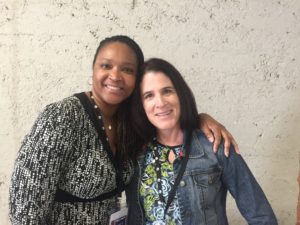How do you do relational Twitter?: Developing your Professional Collaboration Network
Editor’s Note: This post is one in a series about how technology can be used to develop and sustain one’s professional network. The idea for this post came from a think tank hosted by the University at Buffalo’s School of Social Work in June 2019, looking for a way to teach students in their new online Doctorate of Social Program (DSW) program about how to develop key stakeholder networks in relation to a substantive topic area. In this series, we are exploring the concept of a Professional Collaboration Network (PCN), which are technology-mediated user-centered relationship constellations designed to enhance or enrich connections, knowledge, and professional opportunities. This post covers how you can develop and nurture professional relationships with Twitter.
This is the third blog post in a series on using Twitter to create Professional Collaboration Networks (PNCs). Previous posts defined PCNs and discussed the value of Twitter as a network and how it can benefit lifelong learning, and shared some best practices. There are many professional reasons for being on Twitter, including disseminating one’s own work, announcing happenings, seeking help, and learning from others. To be successful in most of these tasks, you need to be plugged into a social network of people who are motivated to share your work. This post addresses how one moves from using Twitter to follow others and announce your work to developing real relationships with the real people at the keyboards.

This post is built from real-life experience of the amazing professional experiences and friendships that can come from the effective use of PCNs. About six years ago, I (Melanie, the first author of this post) connected with a small group of social workers who were using Twitter, which led me to connect with folks like Jonathan Singer (@socworkpodcast) who I went on to present and write book chapters with, and Laurel Hitchcock and Nancy Smyth, with whom I spent three years writing the book Teaching Social Work with Digital Technology. Beyond these meaningful work products, social work relationships on Twitter have evolved into sharing meals, spending time in each other’s homes, and splitting Airbnb’s at social work conferences across the nation. Not to mention people I can lean on, and am happy to support on good and hard days.
A Collection of Resources for New and Emerging Field Directors
Editor’s Note: The idea for this blog post came from the listserv of the Association of Baccalaureate Social Work Program Directors. With over a 1000 subscribers, this listserv gets a lot of action from social work educators, frequently asking for resources or best practices. In January 2020, a discussion thread came up about resources for social workers who were new directors of field education. I reached out to Kristen Samuels, the Director of Field Education at the University of Phoenix, and who has written posts for this blog in the past. She graciously agreed to pull together a list of her favorite resources for field education.
As I transitioned into being a Field Director a few years ago, I had a great deal of anxiety over performing the role well and meeting the expectations of what seemed like an endless list of stakeholders. Although I had experience across many roles in Social Work Field Education, including coordinator, liaison, field instructor, and field faculty, the role of Field Director came with a steep learning curve. I had so many questions about how to manage the complex and competing demands of the role (Buck, Bradley, Robb & Kirzner, 2012), and found comfort in a few particular resources. Below is a compilation of a few of the resources I found most helpful in easing my transition. If you are new to leading the Field Education component of a Social Work program, these are a few ideas on where to start learning more about the Field Director position beyond your immediate university setting.
Training
One helpful resource was an online training series developed by the Council on Social Work Education (CSWE) called Managing a Field Education Program: A Training for New Field Directors. The training was developed by a group of industry leaders with helpful content about the primary roles and responsibilities of a Field Director. For the $150 registration fee, you receive:
Review of Teaching & Learning in Social Work for 2019

It is that time of year again – the annual review of the Teaching & Learning in Social Work Blog. This will be my fourth year reflecting on the work of this blog; the first end of the year post was in 2016. This year, I am thinking more about my motivation for starting and maintaining this blog for the past seven years. As I think back on why I started Teaching & Learning in Social Work, I’d have to say I wanted to be a more confident writer. Academic writing is not easy. This blog helped me to find my academic voice while allowing me to experiment with writing. I try to be personable in the posts I write, using plain language and concise phrasing. While I can say I am more comfortable with my professional writing, the greatest benefit to this blog is having space to share my work and the work of others in a very non-traditional space. Publishing is a peer-reviewed journal is currency for academics, and it is a narrow, rigid, and polished way to share one’s work. By writing blog posts about my work early in the process, I can share with a wider audience including students, social work practitioners and professionals from other fields. I can also as publish work that may never find a home as a journal article, but is still of value to others. For example, I write frequently about my assignments and classroom activities on this blog. I also post information about my conference presentations here so others can easily reference the materials. Overall, I can say with confidence that writing and publishing Teaching & Learning in Social Work has truly be beneficial and motivating for my academic writing.
For 2019, I had three goals for improving the blog:
#APM19 The Flip(grid) Classroom: Utilizing the Microsoft app Flipgrid to promote student learning

Editor’s Note: In this blog post, I have asked four colleagues from the University at Buffalo School of Social Work to share some information about their presentation at the 65th Annual Program Meeting for Council on Social Work Education next week in Denver, CO. Katie McClain-Meeder, Michael Lynch, Todd Sage, and Margie Quartley will share about their experiences using Flipgrid, a video-based discussion forum, in the social work classroom. In full disclosure, they did ask me to record a video for their presentation, so I may be making a guest appearance during the presentation. Also, you might be interested in reading Todd’s previous blog post about FlipGrid – Incorporating Flipgrid into the Social Work Classroom: Tips for #SocWorkEd.
On October 26, 2019 at 10:30 AM, we (Katie MaClain-Meeder, Michael Lynch, Todd Sage and Margie Quartley from the University at Buffalo School of Social Work) will be presenting an interactive workshop titled The Flip(grid) Classroom: Utilizing the Microsoft app Flipgrid to promote student learning, at the Council on Social Work Education’s Annual Program Meeting. We will be in the Governor’s Square 11 in the Plaza Building.
We know that students are increasingly expecting instructors to utilize new technology to enhance instruction beyond the traditional classroom lecture and content. It is imperative that instructors find meaningful and relevant opportunities to integrate tech into the classroom. Our interactive workshop will introduce you to the video discussion app Flipgrid, which allows students and instructors to quickly and easily interact using short video responses that can be captured via computer or mobile technology. We will highlight case examples, including use for field education, new student orientation, and ways to add depth and breadth to in-person and online instruction.
By attending our workshop, you will learn best practices for introducing and structuring Flipgrid for a variety of educational purposes as well as how to manage Flipgrid from the administrative side, including how to grade, respond and manage discussions. The workshop will also culminate with an opportunity for you to set up their own “grid” with support from us, the workshop instructors.
Tips for New Online Social Work Educators

Editor’s Note: Melissa Thompson, MSW is a lecturer at Dominican University in Chicago, IL, and tweets at @mmt98. Nathalie P. Jones, PhD, MSW is an Associate Professor of Social Work at Tarleton State University and tweets at @Dr.NJones. In this blog post, they share their best tips for social work educator who are new to online teaching.
According to the National Association of Social Workers’ (NASW) Technology Standards for Social Work Practice (2017), social workers are urged to use technology in an ethical manner for practice and learning environments. In higher education, we hear about “digital native” students, who have grown up with a life centered on technology and who present as digital super humans. However, research is increasingly showing this concept to be a myth, and that designed learning environments focused on this myth can lead to poor learning outcomes (Kirschner & De Bruyckere, 2017). Another myth we often see among social work educators is the perception that non-traditional students are resistant to the use of technology in the classroom. Recent data from the Council on Social Work Education’s (CSWE) National Workforce Data Brief (2018) shows this to be a myth as well, reporting that when it comes to online education in social work, the highest enrollment rates were non-traditional students.
Digital Advocacy in the Social Work Classroom: Students speaking out online


Editor’s Note: Julia Kleinschmit is a clinical associate professor in the School of Social Work at The University of Iowa, and Breanne Benson is a currently MSW student in the School of Social Work at The University of Iowa. In this blog post, Julia writes about an assignment that uses social media to promote advocacy skills and professionalism among social work students. Breanne offers her experience with the assignment as a student and reflects on how she grew her skills as a future social worker. Julia can be found on LinkedIn, and Breanne is on Instagram at _bmbenson.
Addressing Technology in Changing Social Work Environment
The Council on Social Work Education’s (CSWE) Competency 1: Demonstrate Ethical and Professional Behavior requires social workers to use technology ethically and appropriately to facilitate practice outcomes. Many have focused on the need for confidentiality in electronic communication and social media boundary management. These are important issues, but at the University of Iowa’s School of Social Work, Megan Gilster, Stephen Cummings, and I believed we could also teach MSW students to use their online identities and social media as powerful tools for effective advocacy.


